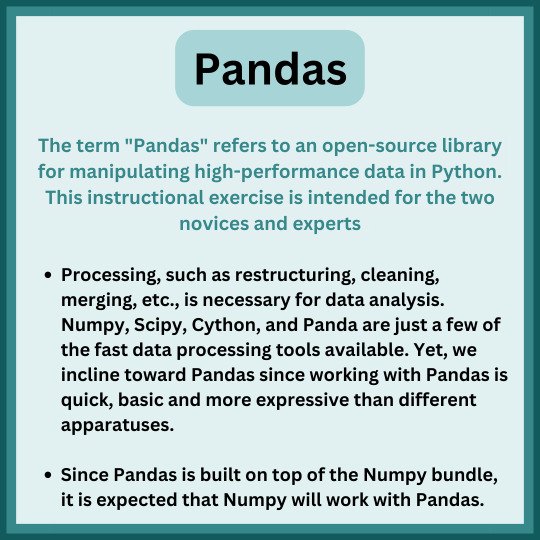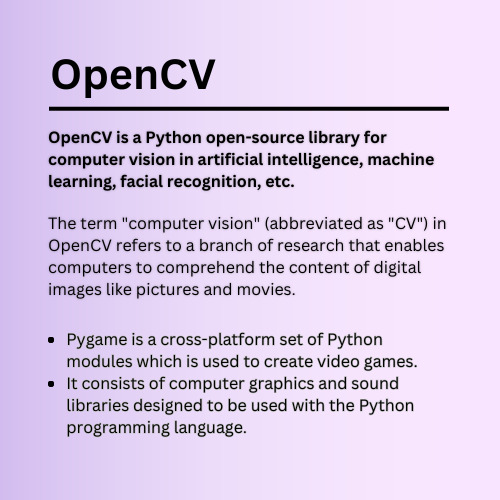#SciPy
Explore tagged Tumblr posts
Text

Pandas . . . . for more information and tutorial https://bit.ly/3jqTlRP check the above link
2 notes
·
View notes
Video
youtube
How To Install SciPy On Python 3.13.3
0 notes
Text
How to Get the Mode with Python and SciPy.
Como Obtener el Modo con Python y SciPy.

#software development#web development#devs#developers#worldcode#developerlife#100daysofcode#machine learning#aprendizaje automático#python#scipy
0 notes
Text
Guide To Python NumPy and SciPy In Multithreading In Python

An Easy Guide to Multithreading in Python
Python is a strong language, particularly for developing AI and machine learning applications. However, CPython, the programming language’s original, reference implementation and byte-code interpreter, lacks multithreading functionality; multithreading and parallel processing need to be enabled from the kernel. Some of the desired multi-core processing is made possible by libraries Python NumPy and SciPy such as NumPy, SciPy, and PyTorch, which use C-based implementations. However, there is a problem known as the Global Interpreter Lock (GIL), which literally “locks” the CPython interpreter to only working on one thread at a time, regardless of whether the interpreter is in a single or multi-threaded environment.
Let’s take a different approach to Python.
The robust libraries and tools that support Intel Distribution of Python, a collection of high-performance packages that optimize underlying instruction sets for Intel architectures, are designed to do this.
For compute-intensive, core Python numerical and scientific packages like NumPy, SciPy, and Numba, the Intel distribution helps developers achieve performance levels that are comparable to those of a C++ program by accelerating math and threading operations using oneAPI libraries while maintaining low Python overheads. This enables fast scaling over a cluster and assists developers in providing highly efficient multithreading, vectorization, and memory management for their applications.
Let’s examine Intel’s strategy for enhancing Python parallelism and composability in more detail, as well as how it might speed up your AI/ML workflows.
Parallelism in Nests: Python NumPy and SciPy
Python libraries called Python NumPy and SciPy were created especially for scientific computing and numerical processing, respectively.
Exposing parallelism on all conceivable levels of a program for example, by parallelizing the outermost loops or by utilizing various functional or pipeline sorts of parallelism on the application level is one workaround to enable multithreading/parallelism in Python scripts. This parallelism can be accomplished with the use of libraries like Dask, Joblib, and the included multiprocessing module mproc (with its ThreadPool class).
Data-parallelism can be performed with Python modules like Python NumPy and SciPy, which can then be accelerated with an efficient math library like the Intel oneAPI Math Kernel Library (oneMKL). This is because massive data processing requires a lot of processing. Using various threading runtimes, oneMKL is multi-threaded. An environment variable called MKL_THREADING_LAYER can be used to adjust the threading layer.
As a result, a code structure known as nested parallelism is created, in which a parallel section calls a function that in turn calls another parallel region. Since serial sections that is, regions that cannot execute in parallel and synchronization latencies are typically inevitable in Python NumPy and SciPy based systems, this parallelism-within-parallelism is an effective technique to minimize or hide them.
Going One Step Further: Numba
Despite offering extensive mathematical and data-focused accelerations through C-extensions, Python NumPy and SciPy remain a fixed set of mathematical tools accelerated through C-extensions. If non-standard math is required, a developer should not expect it to operate at the same speed as C-extensions. Here’s where Numba can work really well.
OneTBB
Based on LLVM, Numba functions as a “Just-In-Time” (JIT) compiler. It aims to reduce the performance difference between Python and compiled, statically typed languages such as C and C++. Additionally, it supports a variety of threading runtimes, including workqueue, OpenMP, and Intel oneAPI Threading Building Blocks (oneTBB). To match these three runtimes, there are three integrated threading layers. The only threading layer installed by default is workqueue; however, other threading layers can be added with ease using conda commands (e.g., $ conda install tbb).
The environment variable NUMBA_THREADING_LAYER can be used to set the threading layer. It is vital to know that there are two ways to choose this threading layer: either choose a layer that is generally safe under different types of parallel processing, or specify the desired threading layer name (e.g., tbb) explicitly.
Composability of Threading
The efficiency or efficacy of co-existing multi-threaded components depends on an application’s or component’s threading composability. A component that is “perfectly composable” would operate without compromising the effectiveness of other components in the system or its own efficiency.
In order to achieve a completely composable threading system, care must be taken to prevent over-subscription, which means making sure that no parallel region of code or component can require a certain number of threads to run (this is known as “mandatory” parallelism).
An alternative would be to implement a type of “optional” parallelism in which a work scheduler determines at the user level which thread(s) the components should be mapped to while automating the coordination of tasks among components and parallel regions. Naturally, the efficiency of the scheduler’s threading model must be better than the high-performance libraries’ integrated scheme since it is sharing a single thread-pool to arrange the program’s components and libraries around. The efficiency is lost otherwise.
Intel’s Strategy for Parallelism and Composability
Threading composability is more readily attained when oneTBB is used as the work scheduler. OneTBB is an open-source, cross-platform C++ library that was created with threading composability and optional/nested parallelism in mind. It allows for multi-core parallel processing.
An experimental module that enables threading composability across several libraries unlocks the potential for multi-threaded speed benefits in Python and was included in the oneTBB version released at the time of writing. As was previously mentioned, the scheduler’s improved threads allocation is what causes the acceleration.
The ThreadPool for Python standard is replaced by the Pool class in oneTBB. Additionally, the thread pool is activated across modules without requiring any code modifications thanks to the use of monkey patching, which allows an object to be dynamically replaced or updated during runtime. Additionally, oneTBB replaces oneMKL by turning on its own threading layer, which allows it to automatically provide composable parallelism when using calls from the Python NumPy and SciPy libraries.
See the code samples from the following composability demo, which is conducted on a system with MKL-enabled NumPy, TBB, and symmetric multiprocessing (SMP) modules and their accompanying IPython kernels installed, to examine the extent to which nested parallelism can enhance performance. Python is a feature-rich command-shell interface that supports a variety of programming languages and interactive computing. To get a quantifiable performance comparison, the demonstration was executed using the Jupyter Notebook extension.
import NumPy as np from multiprocessing.pool import ThreadPool pool = ThreadPool(10)
The aforementioned cell must be executed again each time the kernel in the Jupyter menu is changed in order to build the ThreadPool and provide the runtime outcomes listed below.
The following code, which runs the identical line for each of the three trials, is used with the default Python kernel:
%timeit pool.map(np.linalg.qr, [np.random.random((256, 256)) for i in range(10)])
This approach can be used to get the eigenvalues of a matrix using the standard Python kernel. Runtime is significantly improved up to an order of magnitude when the Python-m SMP kernel is enabled. Applying the Python-m TBB kernel yields even more improvements.
OneTBB’s dynamic task scheduler, which most effectively manages code where the innermost parallel sections cannot fully utilize the system’s CPU and where there may be a variable amount of work to be done, yields the best performance for this composability example. Although the SMP technique is still quite effective, it usually performs best in situations when workloads are more evenly distributed and the loads of all workers in the outermost regions are generally identical.
In summary, utilizing multithreading can speed up AI/ML workflows
The effectiveness of Python programs with an AI and machine learning focus can be increased in a variety of ways. Using multithreading and multiprocessing effectively will remain one of the most important ways to push AI/ML software development workflows to their limits.
Read more on Govindhtech.com
#python#numpy#SciPy#AI#machinelearning#API#AI/ML#onemkl#PYTHONNUMPY#multithreadinginpython#News#technews#technology#technologynews#TechnologyTrends#govindhtech
0 notes
Text
I'm sorry, scipy, but this is just not the Lagrange polynomial for these data!

I was messing around with some data plotting and it seems like none of the python tools will actually plot a 350-degree polynomial fit.
Like I know that plotting a 350-degree polynomial fit is dumb. I'm an educator. I want a graph showing exactly why plotting a 350-degree polynomial fit is dumb, but that requires me to actually get the equation of the 350-degree polynomial fit.
And like calculating the Lagrange polynomial is straightforward. I know a couple ways to do it. But I don't want to have to roll my own code when in theory there are libraries for this.
203 notes
·
View notes
Text

Análisis de Datos! ¡Un mercado muy lucrativo y en constante crecimiento!
¡APRENDE A ANALIZAR DATOS CON PYTHON!
Usando matrices multidimensionales en Numpy, Pandas DataFrames en pandas, bibliotecas SciPy para trabajar con varios conjuntos de datos y a realizar aprendizaje automático usando scikit-learn.
¡Comienza ya mismo!
Pasarás de comprender los conceptos básicos de Python a explorar muchos tipos diferentes de datos a través de clases, laboratorios prácticos y tareas.
¡Aprenderás cómo preparar datos para el análisis, realizar análisis estadísticos simples, crear visualizaciones de datos significativas, predecir tendencias futuras a partir de datos y más!
Aprenderás:
- Importar conjuntos de datos, limpiar y preparar datos para el análisis, resumir datos y construir canalizaciones de datos.
- Utilizar Pandas DataFrames, matrices multidimensionales Numpy y bibliotecas SciPy para trabajar con varios conjuntos de datos.
- Cargar, manipular, analizar y visualizar conjuntos de datos con pandas, una biblioteca de código abierto.
- Crear modelos de aprendizaje automático y hacer predicciones con scikit-learn, otra biblioteca de código abierto.
¡No olvides que estamos aquí para ayudarte y responder tus consultas!
#datascience#dataanalytics#analisisdedatos#pandas#Scipy#BigData#BigDataAnalytics#analizardatos#CienciaDeDatos#numpy#conjuntodedatos#machinelearning#clasesonline#cursos#cursoonline
0 notes
Text

#PythonProgramming#DataAnalysis#DataVisualization#NumPy#Pandas#Matplotlib#Seaborn#SciPy#ScikitLearn#MachineLearning#DataManipulation#CodingInPython#PythonTutorials#PythonCommunity#PythonForDataScience#PythonStats#PythonCoding#PythonVisuals#PythonPackages
0 notes
Text


me and oomf were talking about sora going into the rain to help baby kittens


also self indulgent icecat and scipie
#ninjago#ninjago dragons rising#ninjago fanart#ninjago fandom#ninjago comic#alfonzo frohicky#ninjago sora#kai smith#arin nived#zane julien#ninjago arin#icecat duo#scipie duo#doodles#also APOLOCHEESE chat i didn’t mean to vanish for a few days#i do have things i’m working on but like#doodles r fun#grins#the scipie and icecat were on my mind for awhile anyways#zane making ice kittens for sora is real to me okay#he still makes them subconsciously even though she is away now
990 notes
·
View notes
Text

happy pride from arin and sora :D
#ninjago arin#arin ninjago#ninjago sora#sora ninjago#ninjago dr#ninjago dragons rising#lego ninjago fanart#ninjago fanart#ninjago fandom#ninjago headcanons#arin nived#scipie duo#pride month#ibispaintx#artists on tumblr#digital art#ninjago#lego ninjago
438 notes
·
View notes
Text

OpenCV . . . . for more information and tutorial https://bit.ly/3XAqJYt check the above link
0 notes
Text

I miss themmmmm
#sora ninjago#ninjago art#ninjago lloyd#lloyd garmadon#arin ninjago#arin nived#ninjago#ninjago dragon rising#ninjago dragons rising#found family#ninjago scipie#scipie duo
516 notes
·
View notes
Text


Thinking about NPC/advisor Scipio again, mostly about what if he was standoffish as hell at first because Veilguard needs more assholes. Also I want to reclass him as not a rogue, not a warrior but a secret third thing.
#crow rook#mirror verse scippy….evil scipy#he’s got a beauty mark now bc I couldn’t stop thinking about it#iinadraws#emmrook
652 notes
·
View notes
Text
Please tell me I'm not crazy

UGHHH IM NOT OKAY SCIPIE I MISS YOUUUU
#ninjago#lego ninjago#ninjago dragons rising#ninjago arin#i love ninjago#dragons rising#sora ninjago#ninjago morro#scipie duo#thats arin and sora#I MISS SCIPIE DUOOO
582 notes
·
View notes
Text

thingy because people were doing this on twitter!!
#ninjago#ninjago fanart#ninjago dragons rising#ninjago dr#ninjago nya#ninjago arin#arin ninjago#sora ninjago#ninjago sora#nya ninjago#ninjago lloyd#lloyd garmadon#lloyd ninjago#roby ninjago#ninjago roby#ninjago rapton#ninjago sci-pie#sci-pie duo#scipie duo
158 notes
·
View notes
Text
idk y’all, i’ve just really been thinking about Jacob’s beard.

—-
imagine that he’s in between your legs, has been for what feels like forever, having you cum over and over on his tongue and he has no intentions of stopping, and you’re feeling so good you don’t want him to.
but fuck his beard is starting to make the inside of your thighs burn so much that you’re pulling your hips back into the mattress. “where’re you going baby?” he says finally picking his head up, beard glistening with your arousal.
“Your beard J, it’s starting to sting.” you reply softly, almost ashamed to admit it, glad to have your face slightly hidden in the darken bedroom.
“want me to stop?” he says placing soft kisses on the irritated skin, moving closer to kiss against your sticky swollen lips. he’s not taking his eyes away from yours though, no, even when his mouth is occupied you can’t escape his gaze.
and all you can do is drop your head back to the pillow; sinking your finger through his hair, you pull him back towards your center.
“figured.” jacob smirks, ready to make you come again.
+++++++++++++++++++++++++++++++++++++++++
yeah i need that!
hey y’all!!! i’m going to do a poll or too soon about what you all want to see from this blog so stay tuned!
xoxo
Bunni
#bad boys ride or die#jacob scipio#armando aretas#armando aretas imagine#armando aretas x reader#jacob scipio fic#jacob scipio imagine#jacob scipio x reader#jacob scipio smut#bf!jacob scipio#jacob scipi fluff#jacob scipio concept#olderbf!jacob#secretboyfriend! jacob scipio#armando aretas smut
579 notes
·
View notes
Text

spreading my agenda
#ninjago#lego ninjago#ninjago dragons rising#sora ninjago#arin ninjago#ninjago headcanons#beejay hcs#i love them#my babies#scipie duo#arin and sora#queerplatonic
78 notes
·
View notes